What is best, Honda Civic or Toyota Corolla?
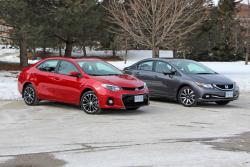 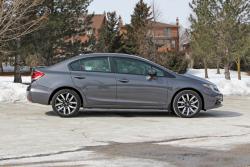 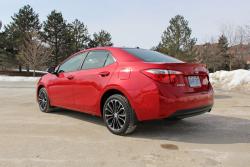 2014 Honda Civic Touring vs 2014 Toyota Corolla S. Click image to enlarge |
Originally published March 12, 2014
Review and photos by Jonathan Yarkony
It’s long past due for us to wade into this age-old rivalry between the Civic and Corolla, two of the bestselling cars in Canada year after year. What makes them so successful? Canadians love value, and the compact segment provides the bare necessities for practicality at the lowest possible price, and because of their popularity, manufacturers are able recoup the costs of high-tech features through economies of scale. Doesn’t hurt that both these iconic compacts are built right here in Canada, the Civic in Honda’s Alliston, Ontario facility and Corollas at a Toyota plant not far from there in Cambridge, Ontario.
Honda has sold no less than 55,000 Civics each of the past 10 years in Canada alone (and as many as 72K in 2008) and last year over 64,000. The Corolla hasn’t quite been able to keep up in Canada usually 10-20K behind the Civic (as little as 36K in 2011, as much as 57K in 2008, and 44,449 last year). In the US, it’s more of a back and forth affair with the Corolla on top some years and the Civic in others, both selling over 300,000 units in the States last year.
The Corolla has always been the safe bet, a practical appliance that promised excellent fuel efficiency, reliability and resale value. For 2014, the Corolla is reimagined as a stylish, sophisticated car that goes beyond logic and necessity. It actually looks nice!
The Civic has a much more colourful past, the cornerstone of the 90s tuning craze giving it street cred that went far beyond its anemic engines and used the reliable bones and engaging drive to create budget driver’s cars. Okay, credit where credit is due: the Corolla also has a cult following for one generation in its history – 1983-1987 Corolla rear-wheel-drive variants, known by its AE86 generation code, which was the car of choice for many racers during the evolution of drifting and immortalized in a cartoon series. This car has nothing to do with the Corolla you see before you.
Anyhow, here in the real world, Corollas are now exclusively front-wheel drive, as are the Civics with which they compete for sales and attention of consumers. Both are powered by variable-valve-timing 1.8L four-cylinder engines, and for our test, we secured two high-trim models, both provisioned with CVT transmissions, and both within $1,000 of each other when all the options were accounted for.
We set out to discover which of these provides the best combination of performance, practicality, ease of use, value and affordability.
Performance
Don’t worry, we’re not going to talk about handling at the limit or enthusiast-oriented aspects of the driving experience. No, we’re far more concerned with how this car performs as a simple commuter and possibly a family car in a pinch.
As mentioned, both the Toyota Corolla and Honda Civic have a 1.8L inline-four under the hood, our testers with the new CVT transmissions each company offers for the first time this model year.
The Civic has an edge in power, with 143 hp and 129 lb-ft of torque, but with an extra 40 kg it shows little of its 11-hp advantage on the road, and that CVT seems a work in progress. Where the CVT in the Honda Accord is brilliant and superior to conventional automatics in its class, here it is shown up by a clever multi-mode CVT in the Corolla.
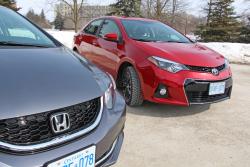 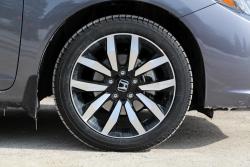 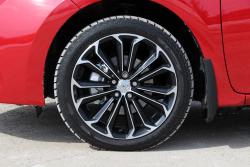 2014 Honda Civic Touring vs 2014 Toyota Corolla S. Click image to enlarge |
The Corolla we tested was the S model, its 132 hp and 128 lb-ft hardly sporty, but the CVT manages to control its lurching revs when accelerating, something that cannot be said for the Civic. The Corolla’s CVT also offers a manual mode with seven simulated gears and paddle shifters to play with them. It’s not crucial for this segment or its mission, but it was handy on occasion.
Far more important than paddle shifter is ride quality. Both Jacob and I found the Corolla’s ride a tad more forgiving, although I found the Civic a touch quieter in controlling the thumps from road imperfections absorbed by the suspension. Of course, for years the darling of the sporting set (and engineered to be the basis for the hotter Si versions) the Civic’s handling and steering were superior in both feel and accuracy, although frankly we don’t feel that will be a priority to the majority of consumers. However, it is worth noting that the Corolla has closed the gap considerably in this area, offering decent steering weight and neutral, stable handling in typical conditions and speeds. Just don’t push it.
Of greater concern to the average consumer is fuel consumption. The EPA suggests that the Civic should come out ahead, its combined rating 7.1 L/100 km to the Corolla’s 7.4, but on our back-to-back driving loops, the Civic posted an 8.9 while the Corolla finished at 7.9, and after driving them for the rest of the week, both went up slightly though the gap remained.
For what it gives up in power, the Corolla is the smoother, more efficient and perfectly capable performer for everyday driving needs.
























































